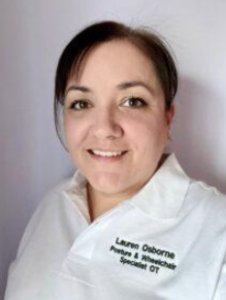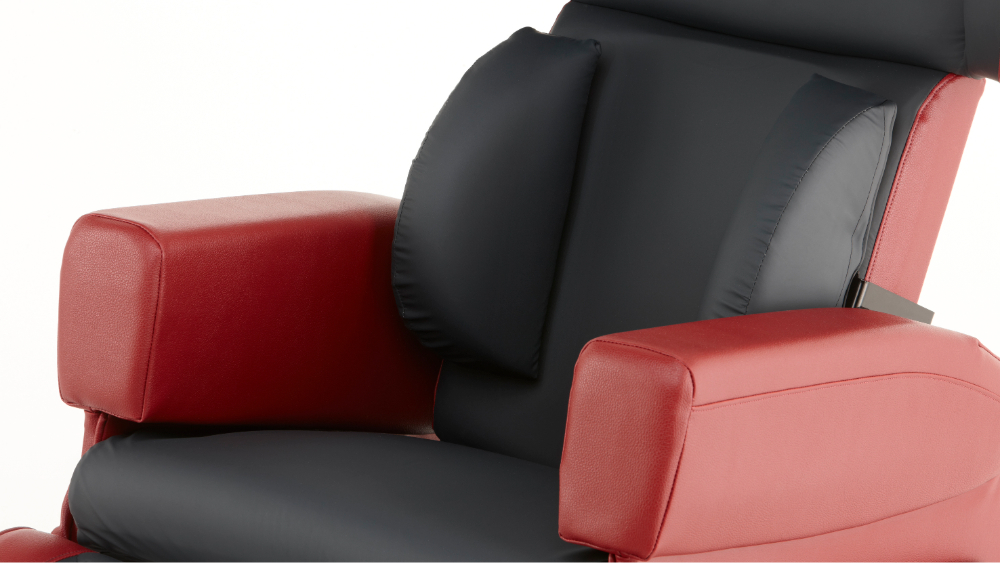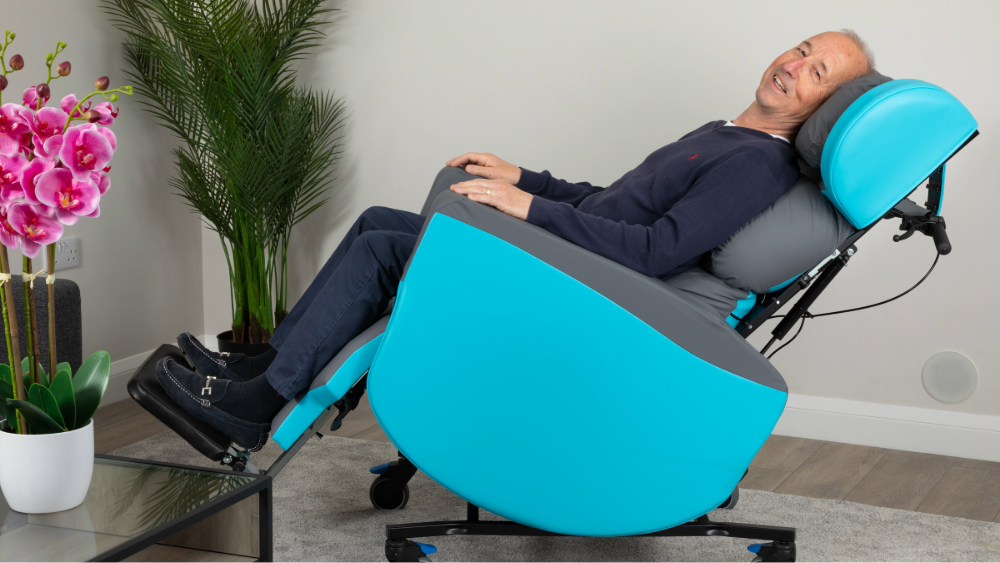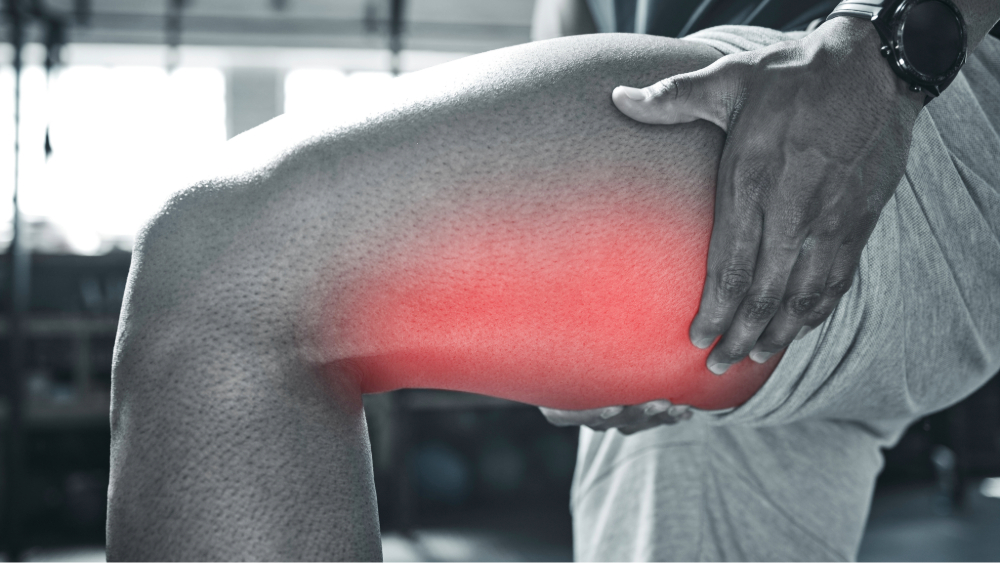The average person spends 7.7 hours a day sitting down and for some people this can be up to 15 hours per day.[i] We have already explored the effects of gravity on posture in previous blogs and how for people who are unable to move independently, the effects of gravity can be devastating if left unsupported. Therefore, for those who require support for their posture, positioning aids become crucial to protecting body shape and alignment of body segments to safeguard against postural deformities and other health implications, such as pressure ulcers, joint contractures, and chest infections.
Positioning aids could be either within the features of a specialist chair or a separate item on their own. They are designed to support the body segments in neutral alignment, safeguarding against the adoption of abnormal postures and the effects of gravity. A positioning aid could be a support around the trunk to enable stability and upright posture, it could be a wedge in the centre of a seat between the legs to prevent the knees clamping together. Or it could be a shaped cushion used to support the body in lying. The main aim is always to support the body in as neutral alignment as possible, counteracting presentations such as scoliosis, pelvic obliquity or wind sweeping of the lower limbs.
There are many proven benefits to being adequately supported in appropriate seating, for example, it can assist with cognitive development in children[ii], as well as increase participation for older adults in care home settings[iii]. Other benefits of postural seating have been listed as improved comfort, increased trunk stability leading to enhanced upper limb function, improved breathing and digestion, reduction in pressure ulcers and feeding difficulties[iv][v]. Whereas inadequate seating can contribute to the development of pressure ulcers[vi][vii], which are well known to be costly for health services to treat.
When assessing complex posture, we identify “point of control”. These are the areas that need support to either protect body shape against distortion or to therapeutically encourage the body into another position. Depending on the need for the positioning aid, if not used correctly, they can pose a risk to the individual’s posture if placed in the wrong position or not fitted properly.
Despite the demonstrated benefits, there is a lack of clinicians with specialist seating knowledge and very little advice in national guidelines to inform the assessment and prescription process, with no national care pathway for seating[viii][ix]. Worryingly, it is possible that further postural damage can be caused by inexperienced Therapists prescribing inappropriate equipment[x] and therefore, anomalies in training for posture management needs to be addressed.
Whilst it may be a multidisciplinary team of professionals who conduct assessments and recommend equipment to be used, it is the day-to-day care givers who actually implement any posture management programme and can therefore be the most effective for the individual[xi]. This presents a training need for those primary care givers, who are crucial to the success of a posture management programme through successful implementation and application of prescribed equipment[xii].
Families and carers are the closest people to the individual requiring posture management support and therefore need to be competent and confident to transfer and position the individual into the equipment so that it is used effectively and does not cause more harm[xiii][xiv][xv]. By instilling some knowledge and understanding of the need for posture management and the benefits it can produce, this could help to reduce any fear or anxieties that caregivers may have of not applying the equipment appropriately and therefore causing harm.
Additionally, posture management equipment is often very expensive and therefore, to not invest in training families and carers in how to use it effectively, is a waste of resources and can also have a negative affect for the individual through insufficient posture management[xvi].
Individual assessment is critical to choosing the correct seating, tailored to meet the needs of the individual based on pressure care needs, postural support required, transfer ability and method[xvii][xviii][xix].
How can CareFlex Specialist Seating help?
At CareFlex, we believe in a person-centred approach. Our experienced Specialist Seating Assessors conduct thorough, no-obligation seating assessments to understand the unique needs of each individual. We meticulously evaluate factors such as posture, pressure risks, and mobility to ensure a precise and beneficial seating solution.
Book a tailored assessment.
Written by our guest blogger, Lauren Osborne, an Independent Posture & Wheelchair Specialist Occupational Therapist.

[i] Just Stand (2010) Sitting Time Calculator, [Online] URL: https://www.juststand.org/the-tools/sitting-time-calculator/ (Accessed 29.02.24).
[ii] Wright, C., Casey, J. and Porter-Armstrong, A. (2010) ‘Establishing best practice in seating assessment for children with physical disabilities using qualitative methodologies’, Disability and Rehabilitation: Assistive Technology, 5(1), pp. 34-47.
[iii] Daly, G. (2017) ‘Prevention and postural management of residents in care homes’, RCOT Annual Conference, pp. 109.
[iv] Maher, C., Evans, K., Sprod, J. and Bostock, S. (2011) ‘Factors influencing postural management for children with cerebral palsy in the special school setting’, Disability and Rehabilitation, 33:2, pp. 146-158
[v] Daly, G. (2017) ‘Prevention and postural management of residents in care homes’, RCOT Annual Conference, pp. 109.
[vi] Collins, F. (2008) ‘An essential guide to managing seated patients in the community’, British journal of community nursing, 13(3), pp. 39-40.
[vii] Daly, G. (2017) ‘Prevention and postural management of residents in care homes’, RCOT Annual Conference, pp. 109.
[viii] Collins, F. (2008) ‘An essential guide to managing seated patients in the community’, British journal of community nursing, 13(3), pp. 39-40.
[ix] Wright, C., Casey, J. and Porter-Armstrong, A. (2010) ‘Establishing best practice in seating assessment for children with physical disabilities using qualitative methodologies’, Disability and Rehabilitation: Assistive Technology, 5(1), pp. 34-47.
[x] Wright, C., Casey, J. and Porter-Armstrong, A. (2010) ‘Establishing best practice in seating assessment for children with physical disabilities using qualitative methodologies’, Disability and Rehabilitation: Assistive Technology, 5(1), pp. 34-47.
[xi] Kittleson-Aldred, T. and Hoffman, L. (2017) ’24-Hour Posture Care Management: Supporting People Night and Day’, Rehab Management [Online] URL: https://www.rehabpub.com/conditions/neurological/cerebral-palsy/24-hour-posture-care-management-supporting-people-night-day/?campaign_type=newsletter&_hsenc=p2ANqtz–kUMNQGN4fls7yg0EZgxLeJXrjMIgyQ2sEqx1D8PMd7Kk1PXpcJ_UqwGhuTcTEXKnSc7PLIo3S_1D33BwuqESombGEgA&_hsmi=62856871 (Accessed 29.02.24).
[xii] Goldsmith, S. (2000) ‘The Mansfield Project: Postural Care at Night within a Community Setting’, Physiotherapy, 86(10), pp. 528-534.
[xiii] Polak, F., Clift, M. and Clift, L. (2009) Buyers’ Guide. Night time postural management equipment for children CEP08030.: London: NHS Centre for Evidence-based Purchasing.
[xiv] Hill, C. M., Parker, R. C., Allen, P., Paul, A. and Padoa, K. A. (2009) ‘Sleep quality and respiratory function in children with severe cerebral palsy using night-time postural equipment: a pilot study’, Acta Paediatrica, 98, pp. 1809-1814.
[xv] Blake, S. F., Logan, S., Humphreys, G., Matthews, J., Rogers, M., Thompson-Coon, J., Wyatt, K. and Morris, C. (2015) ‘Sleep positioning systems for children with cerebral palsy’, The Cochrane database of systematic reviews, (11), pp. CD009257.
[xvi] Polak, F., Clift, M. and Clift, L. (2009) Buyers’ Guide. Night time postural management equipment for children CEP08030.: London: NHS Centre for Evidence-based Purchasing.
[xvii] Collins, F. (2008) ‘An essential guide to managing seated patients in the community’, British journal of community nursing, 13(3), pp. 39-40.
[xviii] Daly, G. (2017) ‘Prevention and postural management of residents in care homes’, RCOT Annual Conference, pp. 109.
[xix] Wright, C., Casey, J. and Porter-Armstrong, A. (2010) ‘Establishing best practice in seating assessment for children with physical disabilities using qualitative methodologies’, Disability and Rehabilitation: Assistive Technology, 5(1), pp. 34-47.



